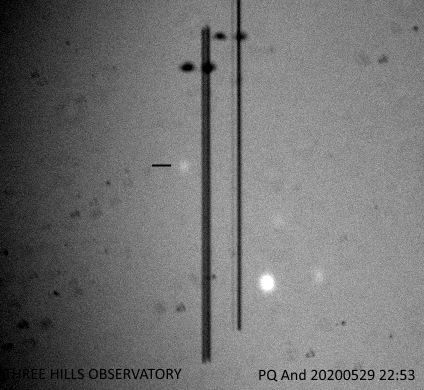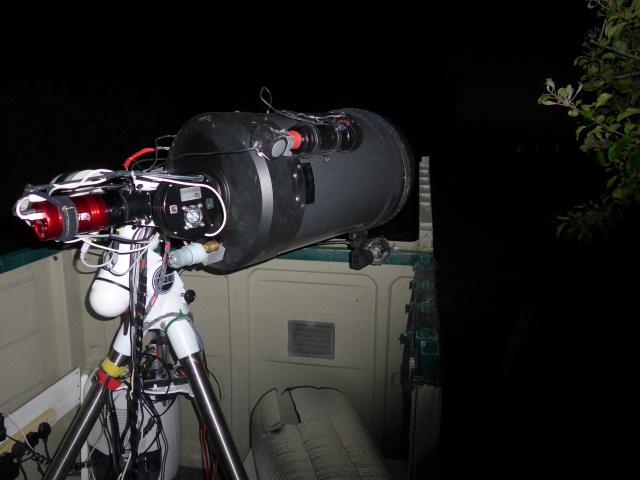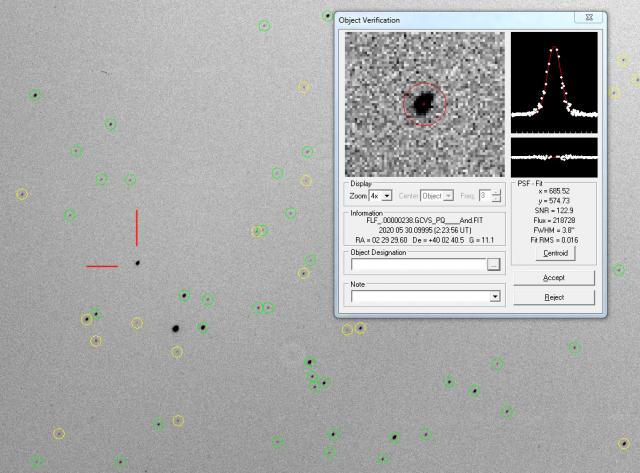› Forums › Variable Stars › PQ And in very rare outburst
- This topic has 42 replies, 12 voices, and was last updated 5 years, 5 months ago by
 Gary Poyner.
Gary Poyner.
-
AuthorPosts
-
29 May 2020 at 9:41 am #574624
 Jeremy ShearsParticipant
Jeremy ShearsParticipantI just sent out a BAA email alert on this important and rare event:
The dwarf nova PQ And has been reported to be in outburst at mag 10.5 on May 28.776 by Kenji Hirosawa (Aichi, Japan). This means that it is some 9 magnitudes above its usual quiescence of 19.5.
PQ And has only been seen in outburst once before when Dave McAdam discovered it as Nova And 1988. So this is its first appearance for 32 years.
Gary Poyner managed to catch PQ And in the dawn sky this morning: May 29.088 at a visual mag of 10.5 using a 22cm Dobsonian on a wobbly table. Eddy Muyllaert of Belgium also observed it visually this morning at mag 10.3, May 29.080.
All observations of this rare outburst are urgently required, both visual and CCD. Time resolved CCD photometry would also be very helpful. It’s of course tricky to observed given the location in the dawn sky.
Dwarf novae are compact binary stars and as they evolve their orbital period gets shorter until it reaches a minimum around 75 to 80 minutes. The orbital period of PQ And is 80.6 mins. There is some speculation that this might be a rare example of a “period bouncer” in which the system has evolved through the minimum and is increasing.
PQ And is located in Andromeda at RA 02 29 29.55 Dec +40 02 40.0 (J2000.0). A finder chart is available from the AAVSO website. Do try to observe this very rare event. At 10th mag it is visible in a small telescope You might have to wait 32 years for the next one!
Jeremy Shears
Director, BAA Variable Star Section
29 May 2020 at 11:41 am #582511 Gary PoynerParticipant
Gary PoynerParticipantI’ve never waited 32 years to see a star for the second time before – but it was worth the wait. On 1988 March 28 I made my first observation of PQ And, detected by my fellow BAAVSS observer and friend Dave McAdam a week before. Tried from the BAA Winchester weekend at Kings Alfred’s college without luck on the 26 & 27, although the skies were very clear – no scopes about! My mag on the 28th was 11.6. By April 13 it had faded to mag 13.0 when I lost it in the NW evening sky.
Three decades later and here I am at 3am in the morning, balancing my trusty old 22cm dobby on a garden table, peering over the hedge to pick out this 10th mag dot low in the NE sky, and hoping the local cat doesn’t jump up, knock everything over and wake up the neighbours – and worse, my wife!!! I have to admit I was beginning to wonder if I’d ever see it again, yet there it was. Couldn’t sleep when I eventually got to bed – too excited. VS are brilliant things to observe.
Gary
29 May 2020 at 12:10 pm #582512 DawsonParticipant
DawsonParticipantHow long will is likely remain mag 10 for?
James
29 May 2020 at 1:04 pm #582513 Gary PoynerParticipant
Gary PoynerParticipantHi James,
Well we only have the historic outburst to go on, which wasn’t that well covered. However looking at the light curve it faded by a magnitude in just 5 days or so, and then two weeks to lose a further magnitude.
UGWZ type stars (if it is indeed one of these) can do wonderful things once they have faded – like re-outbursting a number of times after the primary outburst. They don’t do this every time though, just to keep us on our toes.
It’s going to be very frustrating due to it’s poorly placed position, but must remain hopeful that someone will get some good photometry and or spectroscopy during this outburst – but I’m not holding my breath.
Gary
29 May 2020 at 2:17 pm #582514 Robin LeadbeaterParticipant
Robin LeadbeaterParticipantA tough one. I’ve put out an alert on the main spectroscopy forums. It is (just) circumpolar for me and I although I do have a decent (though currently bright) horizon directly north, I lose it behind a tree as it climbs in the dawn sky
29 May 2020 at 2:58 pm #582515 Jeremy ShearsParticipant
Jeremy ShearsParticipantMaybe a saw, Robin?
Good luck, though. It would be great to get some spectroscopy.
29 May 2020 at 3:20 pm #582516 DawsonParticipant
DawsonParticipantGary / Jeremy, I’ve never made a meaningful observation of anything the VSS is interested in. What sort of settings would you recommend For a DSLR at prime focus? I think the FoV will be too wide with my 80mm refractor so May have to jump right up and use my C11 and Canon 6D. I think I can get to a site with a low northerly horizon that isn’t too light polluted; but 3am though, whose idea was that?!?!?! 🙂
29 May 2020 at 3:31 pm #582519 Jeremy ShearsParticipant
Jeremy ShearsParticipantJames, it’s difficult to say as it’s so dependent on your specific set-up, plus we have a brightening sky to contend with. If we are going to extract photometry from images, the star and its comparisons should not be saturated. This will result in shorter exposures than you might normally consider to get a “pretty picture” (but a pretty picture would also be nice as this is such a rare event!). Thus it’s best is to bracket with a range of exposures. Also avoid saving as a file type that compresses the image, like jpg, as that will involve loss of data.
29 May 2020 at 3:49 pm #582521 Gary PoynerParticipant
Gary PoynerParticipantThe first pretty picture I see I’ll put on front of VSS web page. I’ve just put the 1988 light curve on there too.
Gary
29 May 2020 at 4:44 pm #582523 Daryl DobbsParticipant
Daryl DobbsParticipantPity it didn’t occur later in the year, I live in a valley and have a big hill covered with trees and houses when it clears the hill!!
I hope there will be a report on this later
29 May 2020 at 6:53 pm #582524 Dr Paul LeylandParticipant
Dr Paul LeylandParticipantNo chance of me observing it yet, put I’ve put out a call for help. Let’s see what happens, if anything.
29 May 2020 at 9:34 pm #582527 Nick JamesParticipant
Nick JamesParticipantI remember Dave from the old TA days. A great guy. I chased up a few of his suspects back in the late 80s. I remember discussing the TA/VSS computer archive with him when computers weren’t quite what they are today.
I’ll have a go at getting some images from here tomorrow morning but it will have to wait until the sky is quite bright.
29 May 2020 at 9:45 pm #582529 Nick JamesParticipant
Nick JamesParticipantI’m sure Guy won’t mind me posting this here. This is from my archive as downloaded using a 1200 baud modem…
THE ASTRONOMER Electronic Circular No 137 1988 Mar 24 19.04UT.
Telecom Gold 72:MAG60138
Ed:Guy M Hurst, 16, Westminster Close, Kempshott Rise, Basingstoke,
Hants, RG22 4PP, England. Telephone:(0256)471074.Int:+44256471074
Telex:265871(MONREF G) Quote”72:MAG60138 ATT G.HURST”in FIRST line.
——————————————————————-
VARIABLE OBJECT IN AND= Q1988/18
D.McAdam, Telford, reports his discovery of a variable object in
And. The stellar object, of mag approx 10.5pv is present on two
photos taken on 1988 Mar 21 at 21.36UT and 21.55UT for the UK
Nova/Supernova Patrol. The position is:
RA 02h26.5m DEC +39 50′(1950)
The object was not present on photos of Jan 22 and to date no
variable or asteroid candidate has been found.
Observers with a clear sky tonight are urgently requested to check
the field and report their findings by e-mail using ‘EXPRESS’.
Guy M Hurst29 May 2020 at 9:51 pm #582530 Nick JamesParticipant
Nick JamesParticipantTHE ASTRONOMER Electronic Circular No 138 1988 Mar 26 14.32UT.
Telecom Gold 72:MAG60138
Ed:Guy M Hurst, 16, Westminster Close, Kempshott Rise, Basingstoke,
Hants, RG22 4PP, England. Telephone:(0256)471074.Int:+44256471074
Telex:265871(MONREF G) Quote”72:MAG60138 ATT G.HURST”in FIRST line.
——————————————————————-
TAV0226+39 = VAR OBJ IN AND
M.Mobberley and G.Hurst report confirmation of the new object
announced on E137. Available magnitude estimates (some re-reduced):
1988 Feb 12.802UT,(11.5pv M.Mobberley 85mmFL f2 Tri-X
Mar 15.835UT,( 9.0pv N.James 55mmFL
1988 Mar 21.900UT, 10.0pv D.McAdam 305mmFL f4 K2415
21.913UT, 10.0pv D.McAdam 305mmFL f4 K2415
25.844UT, 10.8pv M.Mobberley 0.36-m f5 refl. Tri-X
25.844UT, 10.6v G.Hurst 0.44-m refl.
N.James, Chelmsford, reports the object is not present on patrol
photos with the following limiting magnitudes:
1986 Dec 6, 10; 1987 Feb 20, 10; Oct 17, 11; Nov 14, 11;
1988 Jan 20, 11; Feb 12, 11.
G.Hurst reports a revised position from analysis of the discovery
photos:
RA 02h26.3m DEC +39 50′(1950)
There is no candidate on Atlas Stellarum to an approx limiting
magnitude of 13.8B. (1969 Aug 9).
Preliminary sequence:
Comp RA(1950) DEC(1950) mv Source
A 02 27.6 +39 57 6.8 CSI
B 02 26.3 +39 47 8.7 M34 Transfer
C 02 25.7 +39 39 9.3 do.
D 02 25.9 +39 39 10.2 do.
E 02 25.6 +39 43 10.6 do.
F 02 26.2 +39 47 10.8 do.
G 02 26.3 +39 49 11.2 do.
The discovery has been communicated to the Central Bureau by telex
and as yet, no independent results have been announced.
Guy M Hurst30 May 2020 at 1:20 am #582533 Robin LeadbeaterParticipant
Robin LeadbeaterParticipantHere it is in the spectrograph guider a few minutes ago (at 5 deg altitude !)
 30 May 2020 at 1:36 am #582534
30 May 2020 at 1:36 am #582534 Robin LeadbeaterParticipant
Robin LeadbeaterParticipantAnd the spectrum against the bright sunlight, strong telluric lines and auroral and atmospheric sodium emission lines.

Note how the spectrum curves down towards the blue end due to the strong atmospheric refraction. Not sure if I can extract much of use from it but it was fun trying !
 30 May 2020 at 3:24 am #582535
30 May 2020 at 3:24 am #582535 DawsonParticipant
DawsonParticipantTaken at 01:34 UT 30.05.2020 with Canon 6D at prime focus on Celestron C11 (15 second exposure, ISO 800); excuse the hot pixels; a cropped version with brightness stretched to show it easier. Have the raw files.
 30.05.2020(BAA).png)
 30.05.2020(BAA)stretched.png) 30 May 2020 at 3:35 am #582536
30 May 2020 at 3:35 am #582536 Nick JamesParticipant
Nick JamesParticipantI had to wait until it was almost daylight for it to clear my house roof but here it is. I’ll need to dig out my nova patrol films from 1989 to see the last time I got it this bright.
 30 May 2020 at 10:05 am #582538
30 May 2020 at 10:05 am #582538 Martin MobberleyParticipant
Martin MobberleyParticipantI filmed Dave talking about his discovery one year later, at the 1989 TA AGM on 1989 June 24 at Basingstoke. I’ve just uploaded the short clip to youtube. No smartphone videos then… A huge shoulder mounted camera and a heavy VHS recorder slung around my neck! Nick conducted the interview. You’ll find it here:
https://www.youtube.com/watch?v=bxfzpvN3oF0
Seems like yesterday!
Regards,
Martin
30 May 2020 at 10:49 am #582540 Nick JamesParticipant
Nick JamesParticipantBlimey, it really was a long time ago. I had some hair then.
Nick.
-
AuthorPosts
- You must be logged in to reply to this topic.
